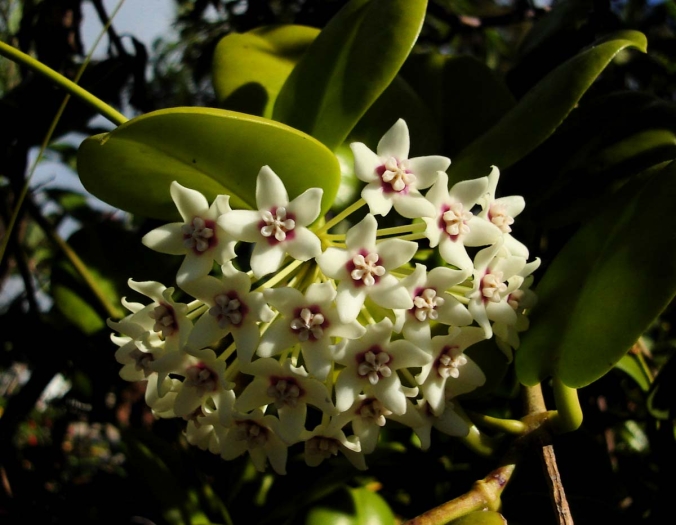Common Waxflower
(Hoya australis)
Common Waxflower (Hoya australis)
/
/

Tauʻolunga
CC BY-SA 3.0
Image By:
Tauʻolunga
Recorded By:
Copyright:
CC BY-SA 3.0
Copyright Notice:
Photo by: Tauʻolunga | License Type: CC BY-SA 3.0 | License URL: http://creativecommons.org/licenses/by-sa/3.0/ | Uploader: Tauʻolunga | Publisher: Wikimedia Commons | Title: Hoya_australis_tonga.jpg | Notes: User created page with UploadWizard |








































Estimated Native Range
Summary
Hoya australis, commonly known as the Common Waxflower, is an evergreen perennial vine native to rainforests and rocky areas in Australasia and the Western Pacific, including Australia, New Guinea, and the Solomon Islands. It can reach lengths of 4–10 m (13–33 ft) and is characterized by its twining stems and glossy, ovate leaves. The plant produces clusters of star-shaped flowers that are 1.5–2.5 cm in diameter, with five thick, waxy, triangular petals. The flowers are predominantly white, with each lobe often marked with a hint of red, and are known for their strong sweet scent and abundant nectar production. Flowering may occur at any time of year, but is most prolific when the plant receives ample light.
The Common Waxflower is valued for its ornamental flowers and is a popular choice for gardens, balconies, and as a houseplant. It thrives in a well-lit position, making it suitable for growing in containers and training on trellises, verandahs, fences, and in glasshouses. Its nectar-rich flowers attract butterflies, adding to its appeal in garden settings. While it can be grown indoors, it requires direct sunlight to flower profusely. It prefers part shade outdoors, low to medium water requirements, and well-drained soil. Hoya australis is relatively easy to maintain, but it can be susceptible to mealybugs and aphids. Regular inspection and prompt treatment of pests are recommended to keep the plant healthy.CC BY-SA 4.0
The Common Waxflower is valued for its ornamental flowers and is a popular choice for gardens, balconies, and as a houseplant. It thrives in a well-lit position, making it suitable for growing in containers and training on trellises, verandahs, fences, and in glasshouses. Its nectar-rich flowers attract butterflies, adding to its appeal in garden settings. While it can be grown indoors, it requires direct sunlight to flower profusely. It prefers part shade outdoors, low to medium water requirements, and well-drained soil. Hoya australis is relatively easy to maintain, but it can be susceptible to mealybugs and aphids. Regular inspection and prompt treatment of pests are recommended to keep the plant healthy.CC BY-SA 4.0
Plant Description
- Plant Type: Vine
- Height: 12-15 feet
- Width: 1-4 feet
- Growth Rate: Moderate
- Flower Color: White
- Flowering Season: Spring, Winter
- Leaf Retention: Evergreen
Growth Requirements
- Sun: Part Shade
- Water: Medium
- Drainage: Medium
Common Uses
Bee Garden, Bird Garden, Butterfly Garden, Fragrant, Hummingbird Garden, Low Maintenance, Showy Flowers
Natural Habitat
Rainforests and rocky areas in Australasia and the Western Pacific
Other Names
Common Names: Waxvine, Honey Plant, Porcelain Flower, Australische Porzellanblume
Scientific Names: , Hoya australis,
GBIF Accepted Name: Hoya australis R.Br. ex Traill